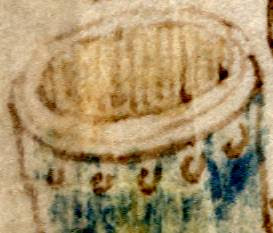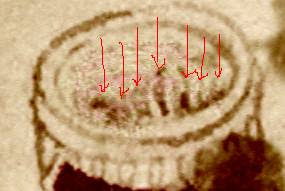In my opinion, the Voynich Manuscript’s nine rosette page has a bit of a problem with its pipes. However, to show you why I think so, I first need to take you on a journey through the rest of the Voynich Manuscript…
Q19A containers
Because of their visual similarity to the pipe tops, let’s start by working our way through all the container tops in Quire 19 (‘Q19’). Q19 is made up of two wide bifolios: every single container depicted in Q19 has what appears to be an open top (i.e. no lid or covering), giving them an initial feeling of having been meant to be bound together.
However, if you look carefully at the containers on the inner bifolio (f100+f101), you’ll see that these are all substantially simpler than the containers on the outer bifolio (f99+f102). This makes me strongly suspect that the containers on the inner bifolio were drawn first.
Hence I’ll start by going through the containers in the inner (simpler) bifolio, which I’ll call Q19A (f100+f101). These container tops all appear to have been filled in with faded light yellow paint, that I think is typical of the earliest stages of construction; there is no sign of vertical parallel hatching; some have rows of dots around them; all are very simple.
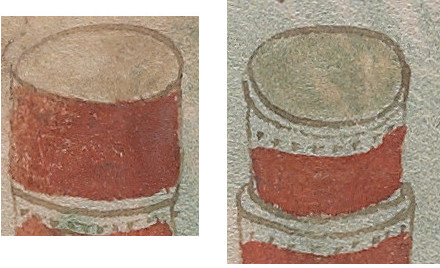
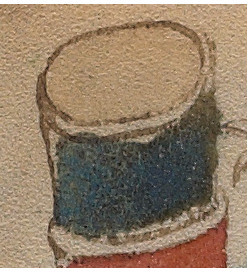
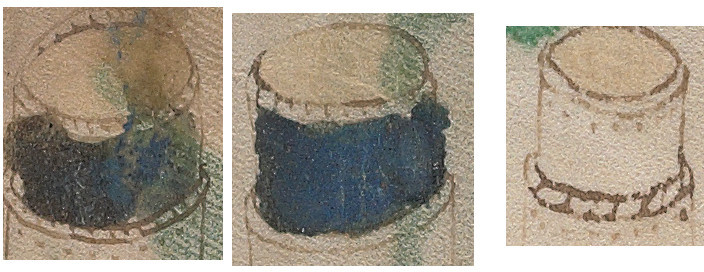
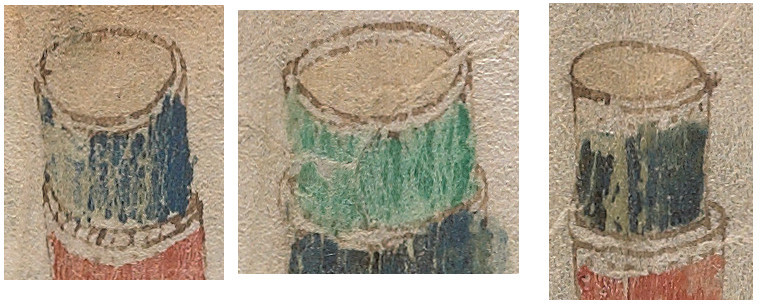
Q19B containers
Contrast the preceding Q19A containers (f100+f101) with the Q19B containers (f99+f102) bound around them. These containers start simple (in fact, almost exactly as simple as all the Q19A containers), but quickly grow in complexity. Rows of dots ‘inside’ the container neck on f99 morph into vertical parallel hatching by f102r1: while the parallel hatching starts by yielding to the surface of a liquid in the container (f102r1), before finally going all the way down the neck of the container on f102v2:

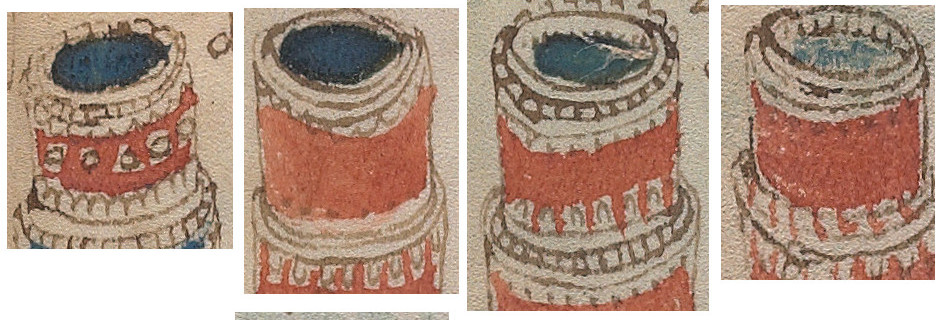
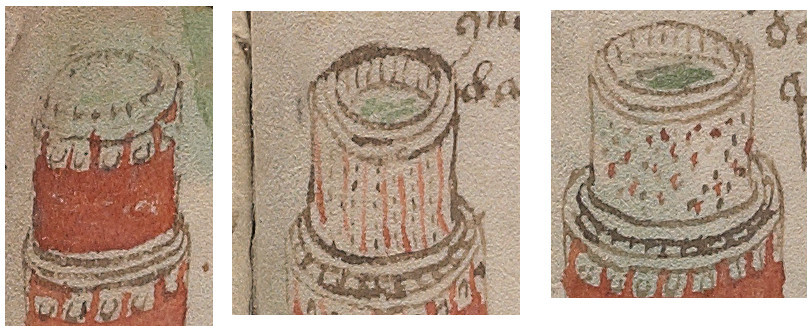

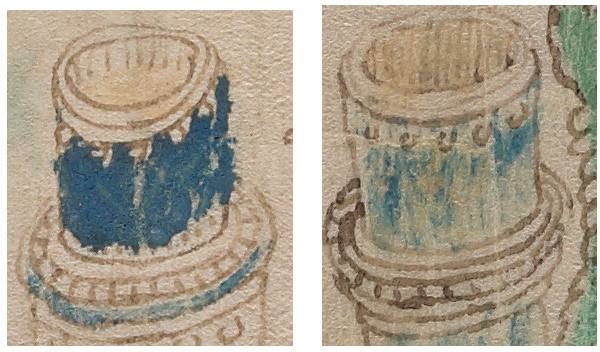
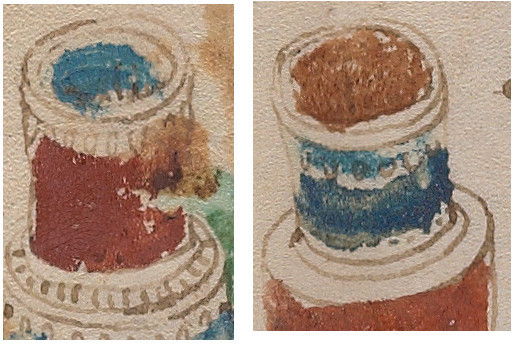
Q15 containers
More than a decade ago, I argued that Q15 was almost certainly intended to have been read after Q19. This was because there is an ever-increasing complexity to the depictions of containers in both quires, growing from simple open-topped containers at the start of Q19 (as above) to Byzantine (and almost impossible to actually construct) containers by the end of Q15.
You can see the direct visual continuity between the last page of Q19 (f102v) and the first page of Q15 (f88r) here (clearly these two were overpainted by different people, using different quality inks and indeed paint strokes):
Q15 has only one open-topped container (top left of f88r, right at the start of the quire), while all Q15’s other containers appear to have lids, again supporting the idea that this top left container marks a kind of hand-over point between Q19 and Q15:
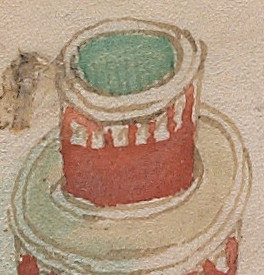
Here we can see full-height vertical parallel hatching inside the container neck (as per the hatching on f102v2), yet another indication that Q15 should probably be read as following Q19B.
Pipe evolution
I believe the way that these pipes are drawn may well be telling us a story about how the manuscript was constructed, e.g. the order of construction (Q19A, then Q19B, then Q15). We’ll use this basic model shortly as a lens to take a fresh look at the nine rosette page’s pipe drawings.
Furthermore, I think it would be interesting to look again at the text patterns on the (Currier A) pharma pages to see if they too follow some kind of evolutionary path mirroring the pipe evolution sequence. The pipes would seem to predict that Herbal A -> Q19A -> Q19B -> Q15.
Marginalia container
We can use our new micro-model to take another look at the container that is part of the f66r marginalia:
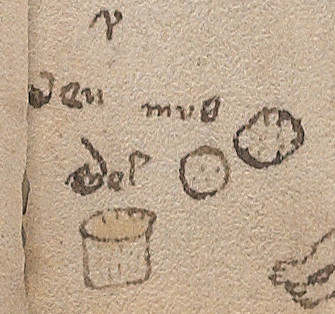
Here we can see the hint of sketchy dots or vertical hatching going down to a painted liquid surface, which would seem to date the marginalia to around the time of the Q19A / Q19B writing phases.
Oddly, f66r is a Currier B page: which would seem to imply that the Currier B on f66r may well have been written before the Currier A on the Q19B bifolio. Something to think about, then.
The NW rosette pipes
OK, so now we’re ready to move onto the nine rosette page (I’ll leave the odd pipes in Q13A and the Pisces/Aries tubs for another day, this is already too long a post).
Let’s start with the single set of pipes in the NW rosette:
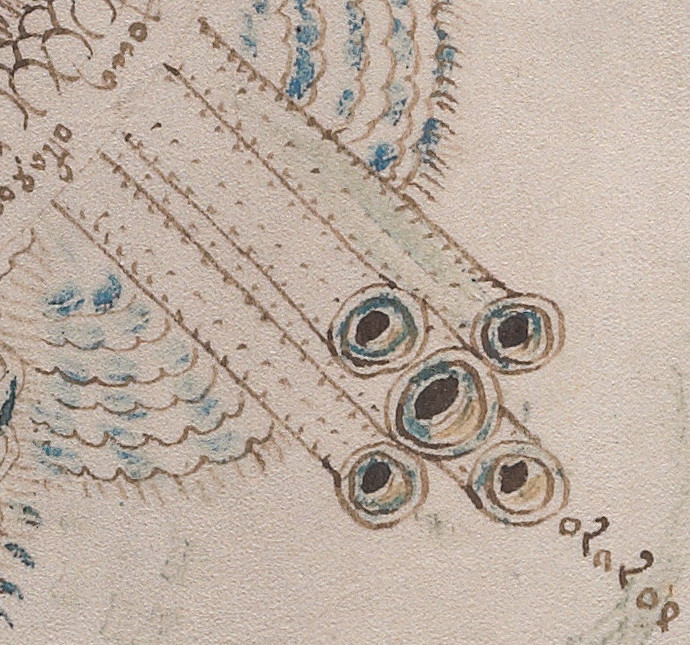
It shouldn’t be hard to see that these pipes have a fair few drawing issues. For a start, the pipe ends are circles, not perspective-style ovals. Also, you can see traces of faint yellow paint inside the circles (none of the other pipes have this). It also looks to me as though the dark areas in the middle have been added over the top of the blue paint. And yet the blue paint on the top left circle seems to have been painted on top of the inner circle.
Further, there are no parallel markings or rows of dots on the inside of the pipes. I’m also not at all clear about the codicological relationship between the blue and yellow paint: I suspect the faint yellow paint was put down first, and then the blue on top at a different time.
Compare these with a typical cluster of pipes from the central rosette:
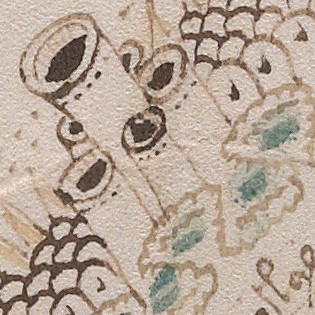
Here, there’s no colour in the pipes at all: there’s (faint) evidence of parallel hatching down the inner back wall of the pipe. The rear pipes of the group are occluded by the dominant central pipe: there are rows of dots along the outside of most of the pipes, just below the front edge of the top rim. The side edges of the pipes are also lined up well with the side edges of the top rims.
It may not be a comfortable starting point, but I can’t easily equate the pipes attached to the NW rosette with the pipes attched to the central rosette. My belief is therefore that the five circles in the NW rosette were originally drawn as free-standing circles (and please don’t ask me what this pattern means, because I don’t know), and that the pipe bodies (and the five central dark areas inside the circular ends, to make them resemble pipe tops) connecting them to the rosette were added afterwards.
Moreover, I suspect that the bodging to the NW rosette’s circles to turn them into pipes was done around the time of the Q19A (simple container layer), while the sophisticated ‘fantasia’ pipes added to the central rosette were probably added after the Q19B/Q15 container layer.
I think this also implies that the pipes all around the central rosette don’t have any actual meaning, but were rather added to try to draw attention away from the five fake pipes in the NW rosette. So, of all the pipework drawings on the nine rosette page, only the five circles (at most) had some kind of actual meaning, while the rest of the pipework there would seem to be decoration and/or distraction.
The other story this seems to be telling is that there was not a simple do-a-single-section-and-then-move-on approach to the construction of the Voynich Manuscript: rather, that multiple layers were added and updated at different times, i.e. with a somewhat more reflective and adaptive mindset.
That is, it would seem that the VMs was not a simple fire-and-forget project, but instead something that involved a lot of thought and practical finessing over a period of time. Quite why it needed so much refinement and empirical subtlety I have no idea: but it is what it is.
Wolkenband Layering
If we look at the bridge between the N rosette and the central rosette, I think we can see at least one type of layering quite clearly:

And no, I don’t think that these are simply an artifact of the scribe sharpening his or her quill, or starting a fresh batch of iron gall ink. I’ll specifically highlight the two layers here:
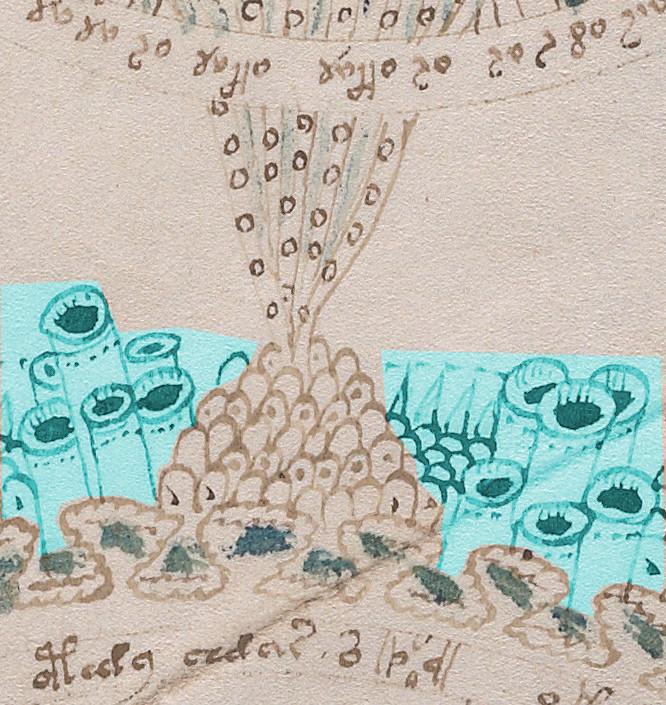
That is, I think that the original outside edge of the central rosette was the wolkenband ‘cloud’ motif (which is, after all, what wolkenbanden signified, i.e. a kind of liminal edge between levels or worlds): and that the pipes around the central rosette were added as part of a separate phase.
This would mean that the central rosette started out as essentially just the exploding onion domes and the wolkenband outer ring: everything else there would seem to be surplus decoration. The north-west rosette too would seem to have originally contained be little more than a series of 37 crescent moons, plus a mysterious set of five circles outside it. (Note that the blue contact transfers near the centre of the NW rosette appear to me to have come from the SW rosette, rather than from a facing herbal or pharma page etc.)
Please understand that I don’t know why any of this should be, I’m merely documenting what I find.


